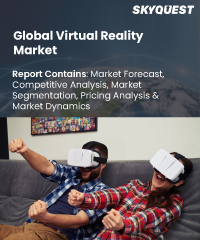
Product ID: SQMIG45J2070

Report ID:
SQMIG45J2070 |
Region:
Global |
Published Date: February, 2024
Pages:
270
|
Tables:
118 |
Figures:
83
Virtual Reality Market Drivers
Implementing New and Emerging Virtual Reality Technology and Applications for the healthcare profession
VR Gaming Systems provide users with an artificially realistic and comfortable experience
Virtual Reality Market Restraints
High Cost of Equipment and Content
Technological Limitations and Challenges
Our industry expert will work with you to provide you with customized data in a short amount of time.
REQUEST FREE CUSTOMIZATIONVirtual Reality Market size was valued at USD 15.75 billion in 2019 and is poised to grow from USD 19.15 billion in 2023 to USD 91.54 billion by 2031, growing at a CAGR of 21.6% during the forecast period (2024-2031).
Want to customize this report? This report can be personalized according to your needs. Our analysts and industry experts will work directly with you to understand your requirements and provide you with customized data in a short amount of time. We offer $1000 worth of FREE customization at the time of purchase.

Product ID: SQMIG45J2070